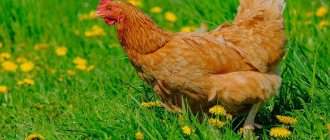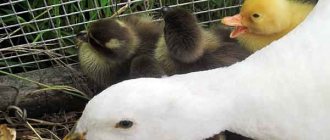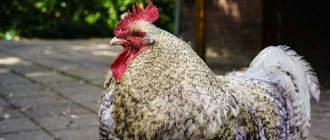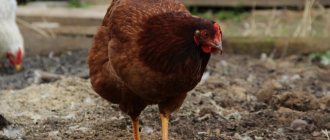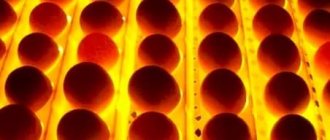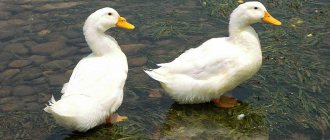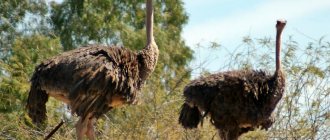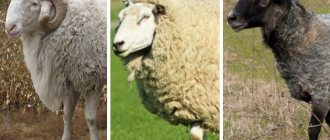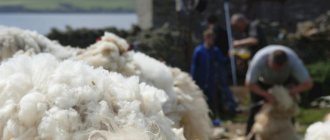Laying hens are found in many courtyards of villages and villages. They are quite unpretentious and delight their owners with homemade eggs for almost a whole year.
However, before you get yourself such a bird, you need to find out which breed of chickens is the most egg-producing for home breeding.
To obtain food eggs, you should choose representatives of the egg direction. The peculiarity of such chickens is their small size, light bones, and most importantly, large and frequent eggs.
In our rating there are also representatives of the meat and egg direction, since they also have high egg production. The list is presented in alphabetical order with the main characteristics of each breed.
IMPORTANT: the peak of egg production occurs in the first 1-3 years of life, after which this figure gradually decreases.
PS. The article describes 10 purebred breeds and 2 crosses (Dominant and Loman Brown) - take this into account, dear readers.
Australorp
These chickens were bred in Australia, where they were very popular in the early and mid-19th century and were found on almost all farms. Black Orpingtons were used as the basis for their production.
Characteristic:
- Egg production (per year): 180-220 pcs. (55-65 g).
- Testicle color: brown.
- Laying hen weight: 2.8 kg.
- When they start laying eggs: 120-150 days.
Chickens have a high egg production. The color is black, in the sun it casts green. Blue and white/gray Australorps are also found. The comb is leaf-shaped, the earlobes are bright red. The bird rushes even in winter, but for this it needs additional lighting.
Black Cochin
- Cochin. Made in China. Meat-type poultry is currently grown for decorative and exhibition purposes. It is characterized by lush plumage, completely covering the entire body and limbs (including toes) with the formation of lush “panties” at the ends. The body shape is round, spherical. The colors are white, blue, fawn, partridge, but the most popular is the black rooster. The Cochin breed has a tendency to become obese. Cold resistant. The live weight of cockerels is from 4.5 to 5.5 kg.
Ameraucana
The breed was created in 1976 by the American Poultry Association. To obtain them, tailless representatives of the Araucana breed were crossed with local egg-laying chickens. The result is a productive layer that produces blue eggs.
Peculiarities:
- Egg production (per year): 210-260 pcs. (60-65 g).
- Testicle color: blue.
- Laying hen weight: 2.6 kg.
- When they start laying eggs: 180-240 days.
A characteristic feature of the Ameraucana is the presence of sideburns and a goatee. The comb has the appearance of a pod; in chickens it is almost invisible. The tail is well feathered, unlike the related Araucana breed. Colors may vary.
INTERESTING! The color of the egg shell is necessarily blue. If it is pink, beige or white, the chickens are not Ameraucanas.
Description of popular fighting breeds
Popular breeds of roosters (photos and descriptions):
- Azil. This word was used by the people of India to call almost all purebred breeds of roosters intended for fighting.
Introduced to Germany in 1860, it is characterized by the following characteristics: strong muscles, stockiness, bonyness, angular shape, short legs, hard plumage and the pronounced character of a real fighter. Such a bird is considered to be fully formed and has reached sexual maturity in the 2nd year of life. - Araucana. It is characterized by brown-red plumage with a black stripe along the feather shaft. The chest, legs and belly are black. A feature of the breed is taillessness - a dominant trait, inherited and caused by the absence of caudal vertebrae.
Among experts it is believed that the tail interferes with combat. Roosters of the Araucana breed are very pugnacious. They reach 1.8 kg in size. A distinctive feature of the breed is the greenish-blue eggs that the hens lay. - Belgian fighting. A fairly old breed of roosters (photo), bred approximately in the 17th century specifically for fighting.
The homeland of such a large, courageous bird with an aggressive posture is Flanders. The back is horizontal, the tail is moderately developed. Weight from 4.5 to 5.6 kg, weight less than 4 kg is considered unacceptable. - Madagascar. They got their name from the island where they were bred by the natives. The bird is strong and hardy, widespread in Europe. Despite their menacing appearance, roosters are very friendly to representatives of other breeds and are even capable of raising chicks instead of a hen. The weight of the rooster is 2-5.5 kg. A characteristic feature of the breed is its bare neck and legs. Color black, red, white, brown.
- Lutticher. A strong, muscular bird with a broad-shouldered, elongated body and rough plumage. The head is powerful, with strongly convex eyebrows. The beak is curved, strong, the color of a dark horn. The chest is wide, somewhat convex. The wings are adjacent and long. The legs are long, bony, straight set. The belly is barely covered with wings, tucked up. The tail is slightly spread out, with good braids. The live weight of the rooster is 4-5 kg. The Lutticher bird has a very grumpy character and a gloomy expression on its “face”.
- Old English fighting. Representatives of this breed of roosters are characterized by strong muscles, a dense body, broad shoulders, covered with neck plumage. The chest protrudes noticeably forward and is rounded at the sides. The neck is long, strong, widening towards the back of the head. The legs are long, with muscular ankles. Set not very wide, they bend well at the joints. The spurs are firm, deeply set, and the hind toe is optimally attached to the ground. Males and females are practically no different in appearance, except that the hens have a better rear design and a fan-shaped tail. The Old English Fighting breed is temperamental, agile, and cocky. Easily adapts to any living conditions. Roosters are friendly towards their owners and have a negative attitude towards their rivals.
- Kulangi. The breed of roosters (photo) is widespread in the countries of Central Asia. Such a bird is characterized by an even vertical carriage of the body, a strong build, and a small, well-sharpened beak. The neck is long, sinewy, slightly curved forward. The head is small, strong, slightly flattened on the sides. The comb is small, roll-shaped. The wings are small and fit tightly to the body. The plumage color is salmon, light brown and black. The legs are high, powerful, and constantly in a widely spread position. At the back there are sharp and very strong spurs. The color of the paws is light yellow, often with fine black pigmentation. The live weight of roosters is 4-7 kg. Due to their natural characteristics, roosters of this breed are very conflict-prone and do not tolerate the proximity of other breeds. The bird is adapted to training and can develop the necessary fighting qualities.
- New England Fighting Modern. Brought out in England in 1850. Over the last century, after the veto of cockfighting, it has represented a decorative type of graceful structure. Roosters of the New England Fighting Modern breed are small. Weight - 2.0-3.5 kg. The body is wide, tapering towards the lower back. The plumage is short, angular, well defined and set back at the shoulders. The back is flat, strongly drooping, the neck is long. The wings are placed high and fit tightly to the body. The tail is narrow and small.
Amrox
The breed was developed in 1848 from Barred Rock chickens in America (Massachusetts). To obtain it, striped Plymouth rocks were used. Amroks are an autosex breed, since chickens can be distinguished by sex on the first day due to a characteristic spot on the head.
Characteristic:
- Egg production (per year): 190-210 pcs. (55-65 g).
- Testicle color: light brown.
- Laying hen weight: 2.4 kg.
- When they start laying eggs: 180-240 days.
The breed is universal. Chickens lay eggs well at home, but the eggs are not very large. Amroks are unpretentious to weather conditions and tolerate cold well. The color is striped black and gray. The leaf-shaped comb is bright red.
Laying hens
They are very active and move a lot; their external difference is their leaf-shaped crest. A chicken can lay eggs at the age of 3-4 months.
Russian white
Has high vitality, good body weight. This breed was bred at the Russian Breeding Center.
Leghorn
Bred in Italy, over time it became known in Russia. It is often found in white color, but can be of any color. A chicken of this type can lay up to 200 eggs per year.
Poltava breed
The color of this breed is brown. The comb is leaf-shaped, bright in color. Egg production per year is up to 170 eggs. Live weight, as with previous species, is 2-3 kg.
Orlovskaya
Chickens of this breed have a dense build and are used at exhibitions. It produces up to 160 eggs per year. But she has good vitality.
Pushkinskaya
Egg production is more than 200 eggs per year. Adapts well to bad climatic conditions. Poultry meat is tasty and expensive.
Araucana
The appearance of this breed is unusual. Arakuna has no tail and wears a feather wig. The shell has a greenish tint.
Loman Brown
The most common specimens of this species are golden in color. Very demanding in terms of accommodation.
Hamburg
An ancient breed that originates in Holland, but it was recognized in the German city of Hamburg. Local chickens were used to obtain it. They are often kept as ornamental, but at the same time they show good egg production.
Peculiarities:
- Egg production (per year): 175-250 pcs. (45-55 g).
- Testicle color: white.
- Laying hen weight: 1.8 kg.
- When they start laying eggs: 120-150 days.
Small chickens with an attractive appearance. They need a large enclosure with a closed top, as they fly well. The colors are divided into two groups: speckled (golden, flesh to tan, silver and lemon with black speckles) and edged (golden and silver).
INTERESTING! There are also black and white chickens. The comb is pink, the lobes are white.
Ancestors and history
The common ancestor of all birds of this species is considered to be the Bankivka (red, jungle) chicken (Gallus gallus), known to people since ancient times. Such birds still live in the tropical jungles of South and Southeast Asia, India and the Pacific Islands. The close relationship between domesticated and banker chickens is confirmed not only by external signs, but also by the similarity of lifestyle, character and behavior. There are known cases of obtaining viable offspring as a result of crossing wild individuals with domestic ones, which indicates a strong genetic affinity.
Wild Bankivsky chickens are considered the progenitors of all breeds existing today
Scientists have differing opinions about the time and region of domestication. Some, following Charles Darwin, argue that the first individuals were domesticated on the territory of the Hindustan Peninsula no earlier than 2000 BC. e. Others believe that keeping chickens as pets was practiced much earlier in other areas. This opinion is supported, in particular, by archaeological research carried out on the territory of modern China. During the excavations, chicken bones were found, the age of which dates back to 5300-5400 BC. e. There is even an opinion that domesticated chickens lived next to humans already in 8000 BC. e. One thing is clear: the species was domesticated in ancient times and became the ancestor of all modern breeds, varieties and crosses (interbreed hybrids). To date, more than 700 names of chicken breeds bred by humans are known. True, 286 of them are now on the verge of extinction, and 32 are considered completely extinct.
One of the ancient Asian varieties is the Bamboo chicken (Chinese silky), known to Europeans since the 13th century according to the descriptions of the famous traveler Marco Polo
Chickens came to Russian territory from China, presumably at the beginning of the New Era. Almost all ancient varieties have not survived to this day. At the turn of the 19th and 20th centuries, mainly birds of foreign selection were bred in the country as purebred birds (“Cochins”, “Faveroli”, “Brams”, “Plymouthrocks”, “Orpingtons”, etc.), however, “local” varieties predominated in peasant farmsteads , originating from chickens introduced several centuries ago. By this time, there were about 80 breeds of Russian selection. Some of them (“Orlovskaya”, “Pavlovskaya”, “Yurlovskaya volosistaya”, “Moscow fighting”, etc.) not only became widespread in our country, but were also highly appreciated by European poultry farmers.
Some well-known breeds of domestic selection can be found in the table:
| Name | Years of introduction (standard approval) | Economic purpose (direction of use) |
| "Pavlovskaya" | Around 1700 (1905) | Decorative |
| "Orlovskaya" | 1700-1790 | Meat and egg, fighting, decorative |
| "Moscow Fighting" | 1850 | Fighting, meat |
| "Yurlovskaya vociferous" | 1920 | Vocal, decorative, meat-egging |
| "Russian White" | 1929-1934 (1953) | Egg |
| "Pervomayskaya" | 1935-1938 | Meat and egg |
| "Moscow black" | 1946-1948 (1980) | Meat and egg |
| "Pantsirevskaya" (black and white) | 1947-1961 | Meat and egg |
| "Kuchinsky Jubilee" | 1947-1959 | Meat and egg |
| "Zagorskaya salmon" | 1950-1959 | Meat and egg |
| "Moscow White" | 1960 | Meat and egg |
| "Adler silver" | 1961-1968 (1994) | Meat and egg |
Currently, in our country (in private farms and on state poultry farms) there are about 85 breeds and breed groups of chickens. Unfortunately, all over the world there is a reduction in the diversity of poultry and a tendency towards the predominance of universal breeds and crosses. There is a program created under the auspices of the UN and aimed at preserving the existing breeds of laying hens for purely meat and ornamental varieties.
Dominant
Numerous crosses bred in the Czech Republic. Includes several varieties of chickens that differ in color, egg shell color and direction of productivity.
Characteristic:
- Egg production (per year): 280-320 pcs. (60-70 g).
- Color of testicles: brown in different shades, cream, blue, green.
- Laying hen weight: 2 kg.
- When they start laying eggs: 120-150 days.
Farmers more often keep grey-speckled, black, blue and silver dominants on their farms. Dominant hens begin to lay eggs early and the eggs are large. The peculiarity of the cross is its demands on the composition of the feed mixture. With a lack of protein and calcium, egg production decreases.
IMPORTANT: when breeding, the egg production of young animals will be much lower, since this is a typical cross.
Common diseases
The Pushkin breed has good immunity. The cause of most diseases is improper care. The development of infectious diseases will be prevented by vaccination.
Common diseases of Pushkin chickens and their main symptoms:
| Disease | Description | Symptoms |
| Newcastle disease | The disease is infectious and incurable | The comb becomes a dark burgundy shade. Sick individuals also experience shortness of breath and bloody diarrhea. |
| Bird pox | The disease is contagious, transmitted through food, drink and sick birds | Yellowish pockmarks on the ridge that turn brown over time |
| Bronchopneumonia | The disease develops with hypothermia. Most often affects chicks no more than a month old. | Mucus production, wheezing, lack of appetite |
| Marek's disease | This infectious disease is incurable | Swollen joints, curled fingers |
| Avitaminosis | The disease develops due to a deficiency of vitamins in the bird’s body. | Feather loss, emaciation, development of conjunctivitis |
Treatment
Treatment of non-infectious diseases can be medicinal and prescribed by a veterinarian. Broad-spectrum antibiotics are most often used.
Treatment of vitamin deficiency involves enriching the diet of a sick chicken with vegetables, fresh herbs and mineral supplements.
Prevention
Infectious diseases usually affect young animals. For this reason, it is not recommended to place adults older than one year and young chickens in the same house.
Basic preventive measures:
- regular cleaning and disinfection of the chicken coop;
- periodic ventilation of the room;
- creating a balanced diet;
- timely vaccination.
Vaccination
Only timely vaccination will help prevent the development of viral and infectious diseases. It is recommended to entrust the choice of a suitable drug to a veterinarian.
Approximate vaccination table for Pushkin chickens:
| Disease | Recommended age of the bird in days |
| Salmonella | 1-2 |
| Marek's disease | 1-3 |
| Coccidiosis | 5-7 |
| Gumboro disease | 20-25 |
| Infectious bronchitis | 30 |
| Newcastle disease | 35 |
| Avian encephalomyelitis | 90 |
Zagorskaya salmon
A domestic breed that was bred in 1955 at the Zagorsk Poultry Institute. It contains the blood of Yurlovsky vocal and Russian white chickens. Representatives of the New Hampshire and Rhode Island breeds were also used.
Peculiarities:
- Egg production (per year): 190-210 pcs. (65-75 g).
- Testicle color: creamy brown.
- Laying hen weight: 2.5 kg.
- When they start laying eggs: 150-160 days.
A bird with a calm character that gets along well with other animals. Unpretentious to diet and ambient temperature. The color of the chickens is light beige, the feathers on the tail and wings are darker. The comb is leaf-shaped.
Breed diversity
Any chickens can be kept for economic purposes, but not all birds are capable of showing high egg production or rapid weight gain. Some varieties have rare external characteristics or other qualities that are of interest to breeders. Therefore, domestic chickens are usually divided according to areas of use into the following large groups:
Egg
They are characterized by high productivity - females of the most successful varieties, when kept in optimal conditions, are able to lay eggs every day, laying up to 300 eggs annually. The bird does not gain impressive weight, but reaches sexual maturity early. The meat of most of these breeds does not have high taste, although there are exceptions. For example, “Shandalar” and “Chernyakhovskaya” chickens, which have quite decent egg production, are kept on farms to produce meat products that are considered “elite” and highly valued by gourmets.
Chickens do not gain much weight, but are distinguished by early puberty and high egg production
Currently, for the mass production of eggs, not only purebred chickens are used (“Leggorns”, “Loman Browns”, “New Hampshires”, “Russian Whites”, “Rhode Islands”, “Bengals”, etc.), but also highly specialized crosses (“Dominant”, “Rhodonit 3”, “Tetra”, “Hisex”, etc.), capable of showing maximum productivity with minimal costs for food and care. Laying hens that produce “colored” (“Easter”) eggs are especially valued. It is believed that such products have a high content of useful substances and even have healing properties.
Meat
Representatives of this group are large birds with a dense build, strong bones and large body weight (adult chickens up to 4.5 kg, roosters up to 5 kg). Egg production is usually low, but females are usually good brood hens and caring mothers. Chicks, especially those crosses bred in recent decades, can reach a slaughter weight of 2.5-3 kg already at the age of 6-7 weeks, which makes their maintenance extremely profitable. At the same time, the taste characteristics of meat products deserve the best reviews from consumers.
Meat poultry is characterized by intensive growth and rapid gain of live weight
Despite the wide distribution of new interbreed hybrids, many poultry farmers prefer to breed purebred birds of this direction (Bram, Cochin, Cornish, Langshanov, etc.). This approach allows you not only to provide your family with high-quality meat, but also to make good money selling purebred chickens and hatching eggs.
Meat and egg
The most common type of domestic chicken in private households, also called universal or general-use. Despite the very different external characteristics, birds of this group are united by unpretentiousness in food and maintenance, as well as a fairly high egg production and the ability to produce meat products of decent quality.
All-rounder chickens are in demand by many poultry lovers, as they are unpretentious in maintenance and provide high productivity in meat and eggs.
Breeding poultry of most pure breeds is not a problem, since females have a developed maternal instinct, and young animals are characterized by high hatchability and survival rates. Getting parental “families” is also not that difficult. Many poultry farms and private owners sell hatching eggs or day-old chicks of popular varieties. However, according to experienced poultry farmers, in most cases, for birds that are expensive and relatively rare on the domestic market, you have to turn to foreign suppliers, since Russian breeders often sell material that does not meet breed standards.
Holocytic
The bird is valued for the ability of males to sing long, loudly and beautifully. In our country, “Yurlovsky vocal” roosters are famous, but this is not the only variety that is bred because of its “vocal” abilities. The most famous breeds of this group are “Drenitsa”, “Bergskaya volosistaya”, “Denizli”, “Ayam-ketava” and some others.
The voices of roosters have different timbres: from bass to falsetto, singing lasts on average 4-8 seconds, some record-breaking individuals are able to perform “vocals” for 12-16 seconds
Fighting
The purpose of breeding these breeds is to obtain roosters intended for participation in fights. This kind of fun has been extremely popular in many countries since ancient times. Around the middle of the 19th century, in most European countries (including Russia), this entertainment was officially prohibited, but not so much because of the cruelty of the spectacle, but because it was accompanied by betting games, which often resulted in losses. huge fortunes. However, in Cuba, in certain regions of France and some Asian countries, cockfighting is still legalized today.
Roosters of fighting varieties can be both large and small
Males must have powerful muscles, strong legs with well-developed spurs, a strong beak with a curved end, long sharp claws, short plumage adjacent to the body and a small crest. Of course, one of the main parameters is the presence of a “masculine” character. Roosters are specially selected and trained to enhance their natural aggressiveness. Such breeds as “Moscow Fighting Dog”, “Shamo”, “Azil”, “Yamato”, “Tuzo”, “Lari”, “Kulangi”, “Lutticher”, as well as English, Belgian, Sumatran and other fighting breeds are widely known in the world. chickens.
Decorative
The bird is bred solely for its appearance. This group includes chickens “Chinese Silk”, “Bantamka”, “Paduan”, “Seabright” and many others, as well as all dwarf varieties of known breeds.
Decorative varieties are distinguished by interesting colors, the presence of crests, fluffy collars and other spectacular plumage features
Various common chickens for household purposes are described in detail in articles posted on our website. Next, we invite you to get acquainted with the descriptions and photographs of some of the “champions” of the chicken world, and learn about why they are interesting for breeders.
Kuchin anniversary
The breed was obtained by Soviet breeders. It was officially recognized in 1990. To breed it, the best representatives of the Plymouth Rock, Rhode Island, Liven and New Hampshire breeds were used.
Characteristic:
- Egg production (per year): 210-260 pcs. (50-65 g).
- Testicular color: red-brown.
- Laying hen weight: 2.8 kg.
- When they start laying eggs: 180-200 days.
A strong, hardy and unpretentious bird. Young animals adapt well to different living conditions. In winter, laying hens continue to produce eggs even at temperatures around +5 degrees. Golden calico color of varying saturation. Leaf-shaped scallop.
Classification
All breeds of chickens are divided according to the following characteristics:
- Direction of use.
- Weight and dimensions.
- Egg production.
- Color, comb shape, color and size of eggs, etc.
According to the direction of human use, chicken breeds are divided into the following types:
- egg direction;
- meat breeds of chickens;
- meat and egg poultry;
- decorative - dwarf and with a very unusual appearance: silk chickens, silver, blue breed, bantam and others;
- vocal;
- fighting breeds of chickens - they are bred mainly in Asia.
Sussex chickens
The most famous chicken breeds by area:
- Egg: Russian white, leghorn, brekel.
- Meat: Cochin, Brahma, Cornish, Faverolles, Sussex chickens.
- Universal: Plymouth Rock, Forwerk, New Hampshire, Faverolles, Rhode Island, Moscow, Amrox, Kuchinskaya, Moscow White, Kotlyarevskaya breed of chickens, Orpington, Leningrad and Dutch calico, Livenskaya breed of chickens.
- Decorative and unusual: bantam, Wyandotte, black Dutch white-crest, paduan, seabright, curly, silky chickens, Andalusian.
- Vociferous: Yurlovskaya vociferous.
- Fighting: Azil, Fighting English, Kulangi, Moscow Fighting, Indian black and blue, Malay.
Azil fighting chickens
Leghorn
The homeland of these chickens is Italy. They gained popularity in the 19th century. The best breeders took part in the breeding, and each of them contributed to the development of the breed. They are actively used to produce highly productive chicken crosses.
Peculiarities:
- Egg production (per year): 260-300 pcs. (55-60 g).
- Testicle color: white.
- Laying hen weight: 1.75 kg.
- When they start laying eggs: 120-150 days.
A small but very productive bird. Laying hens produce about 300 eggs per year and begin to lay eggs by 4-5 months. Leghorns are active and restless chickens. The standard includes two colors: white and brown.
INTERESTING! A characteristic feature of the breed is a large leaf-shaped comb hanging on its side.
Types of roosters by fighting style
Based on the fighting style, fighting cock breeds are conventionally divided into 4 types:
- Straight. When meeting, he immediately rushes at his opponent and hits him in the chest or head with a strong blow.
- Circular. He exchanges a couple of blows with his opponent, then turns around, begins to “circle” (run in a circle), after which he suddenly attacks the enemy again, and, without allowing the latter to come to his senses, runs away again. Thus, he exhausts his opponent, due to which he often wins.
- Sent. He doesn’t run in a circle, but intercepts his opponent in a straight line and hits him straight in the back of the head.
- Thievish. It is highly valued because it competently conducts battle tactics: it tries to remove its head from the blow, goes to its feet, hides under the enemy’s wing, thereby knocking the latter off the pace. He himself seizes the right moment and strikes.
Roosters of different breeds can be fighters from birth and fight using all tactics. Sometimes it seems that these versatile warriors, depending on the opponent's style, are considering which one to use in order to win.
A characteristic feature of the fighting breed of roosters is scanty plumage, which causes poor body heat retention. Therefore, it is recommended to keep such birds in a heated room. The key to caring for fighting cocks is a high protein diet.
Loman Brown
This cross was obtained by German breeders in 1970. Information about the breeds that were used to produce these chickens is still kept secret. On the first day, chickens differ in gender (cockerels are light, and hens are darker).
Characteristic:
- Egg production (per year): 310-320 pcs. (60-65 g).
- Testicle color: light brown.
- Laying hen weight: 1.8 kg.
- When they start laying eggs: 120-150 days.
One of the most popular chickens. However, they have a peculiarity - productivity drops sharply after 2 years of life. At home, it is impossible to obtain young animals with the same egg production rates. The color is brownish-red, the tail has a lighter shade.
How to choose the right breed?
Chickens of different colors
Which breed of black or blue chickens should you choose? You need to resolve this issue based on your capabilities and preferences. It would be more correct to evaluate all the necessary factors, only then make a choice.
Egg production
If you need a chicken for eggs, you should consider the breeds of laying hens and compare the number of eggs they can produce in a year.
Popular breeds:
- Avicolor - from 250 eggs per year;
- amrox – from 200 eggs per year;
- Welsumer - from 150 eggs per year;
- maran - up to 150 eggs per year;
- Oryol Russian - up to 150 eggs per year.
In order to have your own eggs from laying hens all year round, you should choose purebred chickens or crosses with high productivity.
Hen hatching eggs
How to choose?
To choose a bird that will lay eggs, you need to pay attention to some criteria.
What to pay attention to:
- buy birds in the spring, at the age of about five months - then their peak egg production will be in the summer. when there is long daylight;
- it is preferable to choose birds from farmers, they live in free conditions, therefore they are in good health (the main thing is to check the health of the individuals);
- the bird must be clean, well-groomed, with uniform plumage;
- It is better to discard an individual with dirty, stuck together feathers, this may be a sign of infection;
- the distance between the bones of the pubis should be from three to four centimeters;
- the individual’s belly should be soft, this will be evidence that it was fed moderately, not too much and not too little;
- the beak should close tightly and evenly;
- a healthy bird will not sneeze or have nasal discharge;
- the skin under the feathers should be pink, without wrinkled areas or sagging;
- do not buy chickens that show signs of both sexes - such birds will be unproductive.
Chickens at a poultry farm
It is better to choose laying hens of approximately the same age and weight, so that it is easier to care for them, and their egg production is approximately the same.
Pushkinskaya
The breed was obtained in the city of Pushkin, from where it took its name. It was approved only in 2008. There are two lines of this breed: selection from St. Petersburg and Sergiev Posad. They differ in color and appearance.
Peculiarities:
- Egg production (per year): 210-260 pcs. (70-75 g).
- Testicle color: white.
- Laying hen weight: 2.5 kg.
- When they start laying eggs: 120-150 days.
Pushkin chickens are the most suitable breed for private households. They are unpretentious and begin to lay eggs early. The egg is very large, weighing about 70-75 grams. Chickens are unpretentious to air temperature and diet.
IMPORTANT! The color of laying hens bred in St. Petersburg is variegated, black and white, with a pink comb. Chickens obtained in Sergiev Posad are darker, gray-black, with a leaf-shaped comb.
Andalusian
The name of the breed of these ash chickens corresponds to the place of breeding - they come from Andalusia (southern part of Spain). The plumage is gray-blue, each feather has a dark border. Birds are heat-loving. The chickens are squat, with a short back, voluminous belly, large comb, falling to the side. Cockerels are larger than females, they also have a large comb, but rolling over on their side is not allowed. The earlobes are white. The weight of individuals is 2-3.5 kg. Egg productivity – 180-200 pieces weighing 60 g each.
Russian white
In the first half of the 19th century, breeders began crossing Leghorns with various outbred chickens. After obtaining the first productive hybrids, they were bred “inside”. As a result of further work, Russian white chickens were obtained.
Characteristic:
- Egg production (per year): 200-235 pcs. (55-60 g).
- Testicle color: white.
- Laying hen weight: 1.75 kg.
- When they start laying eggs: 150-180 days.
A small bird whose weight does not exceed 1.8 kg. Chickens are unpretentious, but very active and need a lot of walking. The color must be snow-white. The comb is large and red, hanging slightly to the side (the breed adopted this feature from Leghorns).
Brief characteristics of interesting chicken breeds with photos
"Serama" The smallest breed of chickens. Bred in Malaysia. An adult is comparable in size to a pigeon and weighs no more than 300 g. The body is elongated upward. The tails (both males and females) are composed of hard feathers that can form an upright "fan". The wings are highly developed, so the bird flies well (an indoor aviary is required for keeping). In a year, the female lays 55-60 eggs, about 15 times smaller than ordinary chicken eggs. The brooding instinct is well developed, but chicks older than 7 days cannot be left with their mother: she can peck them (this feature is considered a breed characteristic).
The color of the feather can be different: light brown, grayish, pockmarked, black-red, motley, etc.
“Jersey Giant” Recognized “heavyweight”, bred in the USA. The largest chickens. Males can reach a body weight of 6 kg. The breed is used as a universal one, since the egg production of females remains at the level of 170-200 eggs per year. Disadvantages include a poorly developed maternal instinct, a high need for feed, as well as some maintenance features associated with the large weight of adult birds (the need for special perches, a spacious chicken coop, etc.).
The bird is unpretentious, resistant to cold, has a peaceful, calm character
"Malayan Fighting" Homeland - India and the islands of the Malay Archipelago. One of the most famous large breeds, the roosters of which are bred for fighting. A male can weigh up to 5 kg, but he is famous for more than that. "Malays" are the tallest chickens on the planet. The bird has a classic “fighting”, vertical body position, as well as very long legs and neck. Because of this, the average height of an adult is 65 cm, but there are specimens up to 90 cm in height. The color of the plumage can be milky, brown, black, wheat and pure white.
The bird has decent economic qualities and can be used as a universal
“Chinese Silk” A breed with a thousand-year history, one of the most famous decorative ones. The bird is small; The live weight of the cockerel does not exceed 1.5 kg. “Silk” chickens are interesting because their feathers have a specific structure: due to the absence of “hooks,” they do not adhere to each other. As a result, the entire plumage looks like a tousled bunch of delicate, long, silky hairs. The body, legs and head of the bird seem to be covered with fur. Its color can be different, but not only black, but also red, gray and white chickens of the Chinese Silk breed have skin, bones and a beak of a bluish-black color. Breeding such birds is not easy: they are afraid of cold and dampness, and require constant and very careful care. However, such difficulties usually do not bother future owners. “Silk” birds are extremely profitable: purebred chickens are expensive and sell well, and eggs and meat are valued as delicacies.
Another characteristic of the breed is the unusual structure of the paws - they are five-toed.
"Bantam Seabright" Bred at the beginning of the 18th century in England. The most “correct” and “classic” of all “ripples”. Each feather of this small (up to 600 g) bird is strictly edged with a thin black stripe. The main shade of the feather can be silver or golden-red. Chickens are bred as decorative animals, but their eggs are considered one of the most delicious and healthy. A female can lay up to 110 pieces per year.
The bird has a good-natured and cheerful disposition, is quite unpretentious, does not require complex care and is perfectly tamed.
“Onagadori” (“Phoenix”, “Yokagama”) Bred in Japan, considered the “national shrine” of the country. The most “long-tailed” chicken on Earth. Roosters' tail feathers grow throughout their lives. Over the course of a year, the length increases by an average of 90 cm. In their homeland, the most “outstanding” individuals live in high, narrow enclosures, and their tails are specially curled for walks. A long-lived male is known who lived to be 17 years old and at this “venerable” age had a tail more than 13 meters long. Russian breeders usually do not strive for “records” of this kind, and it is almost impossible to get such a bird outside of Japan.
Domestic fanciers usually purchase cheaper and less “tailed” “Phoenixes” of German selection and keep them in ordinary chicken coops as ornamental birds
Sussex
An English breed that was developed at the beginning of the 19th century. It was obtained by crossing representatives of the Brahma, Dorking and other breeds with outbred chickens. As a result of constant selection work, the egg production of Sussex laying hens has improved.
Peculiarities:
- Egg production (per year): 150-200 pcs. (55-65 g).
- Testicle color: yellow-brown.
- Laying hen weight: 2.8 kg.
- When they start laying eggs: 180-240 days.
The chickens are medium sized, friendly and calm. They get along well with other birds and are prone to incubation. The color is white, there is a characteristic rim of black feathers on the neck. The tail is dark. The scallop is red, leaf-shaped.
There are many breeds of chickens, but not all of them have high egg production. To keep on a private farm and obtain a large amount of eggs, it is better to choose a calm and peaceful bird of the egg type, unpretentious to the conditions of detention and diet.
Note: a well-designed menu is the key to high egg production of chickens.
The most popular crosses
This section contains breeds of chickens and a description of the category of crosses. These are hybrids obtained by crossing poultry and other individuals.
Avicolor
Avicolor rooster and hen
This breed of bird was bred in Ukraine, specifically for distribution among local farmers. Chickens are unpretentious in keeping and have a calm character.
Poultry productivity: crosses, meat and eggs. How much does a rooster weigh: from 2.1 to 3.5 kilograms. How much does a chicken weigh: from 2.1 to 3.5 kilograms. Egg production ability: average – from 250 eggs per year. Size of laid eggs: average - from 45 to 60 grams.
Important features: nice appearance. Subtleties of keeping: can be kept both in a cage and in an enclosure.
Advantages and disadvantages
lack of aggressiveness;
high egg production.
short productive period;
offspring are not capable of reproduction.
Hercules
Hercules chicken
The best breed of chickens is highly popular, has an impressive weight, and lays eggs well.
Poultry productivity: crosses, meat and eggs. How much does a rooster weigh: from 3.6 kilograms. How much does a chicken weigh: from 2.1 to 3.5 kilograms. Egg production ability: average - from 150 to 200 eggs per year. Size of laid eggs: average - from 45 to 60 grams.
Important features: matures quickly, often produces eggs with two or three yolks. Subtleties of keeping: suitable for keeping in the southern regions, chickens need to be fed frequently and abundantly, protected from drafts.
Advantages and disadvantages
immunity;
productivity;
Young animals can be slaughtered starting from the fourth month.
may suffer from obesity;
after one hundred and twenty days, the taste characteristics of meat may decrease.
Dominant
Dominant breed rooster
This is a Czech breed of chicken bred to be kept in large poultry farms.
Poultry productivity: crosses, meat and eggs. How much does a rooster weigh: from 2.1 to 3.5 kilograms. How much does a chicken weigh: from 2.1 to 3.5 kilograms. Egg production ability: average – from 250 eggs per year. Size of laid eggs: average - from 45 to 60 grams.
Important features: they begin to lay eggs at four months. Subtleties of maintenance: it is difficult to create the necessary care; they are more suitable for industrial maintenance with constant maintenance of all necessary conditions.
Advantages and disadvantages
individuals mature early;
eggs are delicious;
rush daily.
chicks are poorly hatched;
In winter they show aggression.
Star
Star chicken breed
It is not a recognized breed suitable for any purpose. In a week, such a hen can lay up to five eggs, only in cold weather it lays a little worse.
Poultry productivity: crosses, meat and eggs. How much does a rooster weigh: from 2.1 to 3.5 kilograms. How much does a chicken weigh: from 2.1 to 3.5 kilograms. Egg production ability: average - from 200 to 250 eggs per year. Size of laid eggs: average - from 45 to 60 grams.
Important features: the bird develops quickly and can lay eggs after reaching five months. Subtleties of content: no special conditions are required.
Advantages and disadvantages
ease of care;
adaptability;
good egg production.
difficult to find on sale.
Loman Brown
Loman Brown chicken
This breed of birds is considered the most egg-laying; to create it, four breeds of chickens were crossed. Therefore, it enjoys well-deserved popularity all over the world.
Poultry productivity: crosses, meat and eggs. How much does a rooster weigh: from 2.1 to 3.5 kilograms. How much does a chicken weigh: from 1.6 to 2 kilograms. Egg production ability: average – from 250 eggs per year. Size of laid eggs: average - from 45 to 60 grams.
Important features: they lay a lot of eggs, in winter you need to keep the coop warm. Subtleties of keeping: can be kept in a poultry house or mesh cage, the temperature must be maintained at seventeen degrees.
Advantages and disadvantages
can produce more than three hundred eggs per year;
ripens after four months;
easily adapts to any food supply.
after eighty weeks, egg production decreases;
It is difficult to create offspring outside the laboratory.
Shaver
Shaver rooster and hen
This bird is also called the Dutch egg cross. Chickens lay eggs well, even regardless of what food they are fed. They can be bred either on a specialized farm or in a simple country house.
Poultry productivity: crosses, meat and eggs. How much does a rooster weigh: from 1.6 to 2 kilograms. How much does a chicken weigh: from 1.6 to 2 kilograms. Egg production ability: average - from 200 to 250 eggs per year. Size of laid eggs: average - from 45 to 60 grams.
Important features: loves to move, begins to lay eggs at five months. Subtleties of content: there are no difficulties.
Advantages and disadvantages
resistance to diseases;
shell strength;
life expectancy;
endurance.
prone to obesity.
Decorative breeds
These are the most beautiful individuals that have many features. They are grown for decorative purposes.
Bantams
These are Japanese dwarf birds. They are characterized by high activity and ease of care. Birds are black, brown, and speckled in color. They can hardly stand the cold. The bird produces 85-100 eggs.
Seabright
These are graceful dwarf chickens that are characterized by a trusting disposition. They can fly and easily adapt to any conditions. The meat has excellent taste. A laying hen produces 100 eggs.
Padua
This is a rare meat-egg breed. It is characterized by a long thick crest that forms a cap on the head. However, the earrings and comb are missing. Birds are characterized by a blue beak. Egg production – 120 pieces.
White-crested Dutch blacks
A white crest is visible on the head, which contrasts with the dark plumage. Roosters weigh 2.5 kilograms, hens weigh a little less - 2. Laying hens produce 100-140 eggs.
Curly
This is an ornamental meat-egg variety that has raised feathers. This gives the bird a shaggy and disheveled appearance. The paws are also covered with feathers. Birds are characterized by a friendly nature. The annual egg production reaches 120 eggs.
Shabo
This is a meat-eating Japanese variety characterized by short legs, long wings and an erect tail. The chicken is considered friendly and unpretentious. Egg production parameters reach 150 pieces.
What does a rooster look like?
Initially, you need to understand that each rooster looks different. However, characteristic features are still present in appearance. The first is bright plumage, although it varies among all individuals, even within the same species, it is certainly bright.
The second is the tail. They are long and fluffy, and the color of the tail is as colorful as the whole body. The head of this bird is decorated with a crest, popularly called a crest. Its color may vary, but in most cases it has a red tint. The beak is small, but sharp and slightly curved towards the bottom. Under the beak and on the sides of it, the rooster has fleshy flaps called a beard.
These birds have quite long, relative to their height, and strong legs with three toes and a spur on the back of the paws, which they use for defensive purposes. The number of fingers varies among different species. A rooster can hardly be called a small bird, since adults are capable of growing up to 30-50 centimeters in length, and reaching a weight in the average range of 2-4 kilograms.
Rooster photo
Meat breeds
Such birds are raised to produce tasty dietary meat. Therefore, they are very popular among farmers. Representatives of such breeds are characterized by a powerful body and loose feathers. They have a phlegmatic character and tasty meat.
Corniche
Initially, the breed was a fighting breed. However, later they began to grow it as meat. A chicken lays 90-130 eggs per year. The weight of females reaches 3 kilograms, males - 4. The meat has a good taste.
Brahma
This is a powerful breed with a calm nature. She is unpretentious in care. Raising chickens is easy. Feathered legs are considered a special feature of birds. They lay 160 eggs per year. The chicken weighs 4 kilograms, the rooster - about 5.
Chickens are characterized by late maturation. They have many types. Birds have tasty meat, but it is a little rough.
Cochin
This Chinese variety is characterized by its impressive size. It is characterized by a strong body, a wide chest and a small head with a crest resembling a leaf. A chicken weighs 4 kilograms, a rooster weighs 5. The bird produces no more than 120 eggs per year.
See also
Description and characteristics of Dutch chickens, keeping the white-crested breedRead
These chickens are easy to care for. They are considered hardy and have an excellent appetite. Raising birds helps produce a lot of tasty meat.
Faverolles
This species of birds was bred in France. Individuals are characterized by a massive body, low paws and a small tail. The weight of the birds does not exceed 3 kilograms. An indisputable advantage is the ease of plucking the carcass.
Birds become strongly attached to their owner. They have a friendly character and powerful build. The meat has a pleasant taste. Representatives of the breed have a tendency to be overweight, so it is recommended to control their diet.
La Flèche
Chicken weight – 3-4 kilograms. It is characterized by gray feathers with a green tint. A distinctive feature is the V-shaped ridge.
How does the fertilization process occur?
Chickens are living creatures that do not have a sexual organ. The process of reproduction occurs through the cloaca - an expanded fragment of the hindgut that opens outward through a small hole under the tail.
When a rooster impregnates a hen, his cloaca inverts and the gonads begin to release seed. The cloaca of the male and female meet, and the seed penetrates inside the female, remaining viable for up to three weeks. Eggs laid during this time period will be fertilized.
The chicken ovary looks like a bunch of grapes of different sizes, which are eggs. The size of the grape depends on what stage of development the egg is at. Every day, one egg matures in a laying hen, which, having shed its shell, is separated from the bunch and sent to the oviduct. From there it enters the cloaca, where the rooster's seed awaits it.
The direct connection of the sperm with the egg is characterized by the acrosomal reaction, when the thread emerging from the body of the sperm penetrates into the egg. The male reproductive cell penetrates the female, with only the head, which carries genetic data, getting inside, and the tail is separated.
About 20-60 active sperm penetrate a chicken egg, but only one of the fastest “tadpoles” fuses with the egg. Within 23-24 hours, the egg acquires a shell and after this time it comes out.
